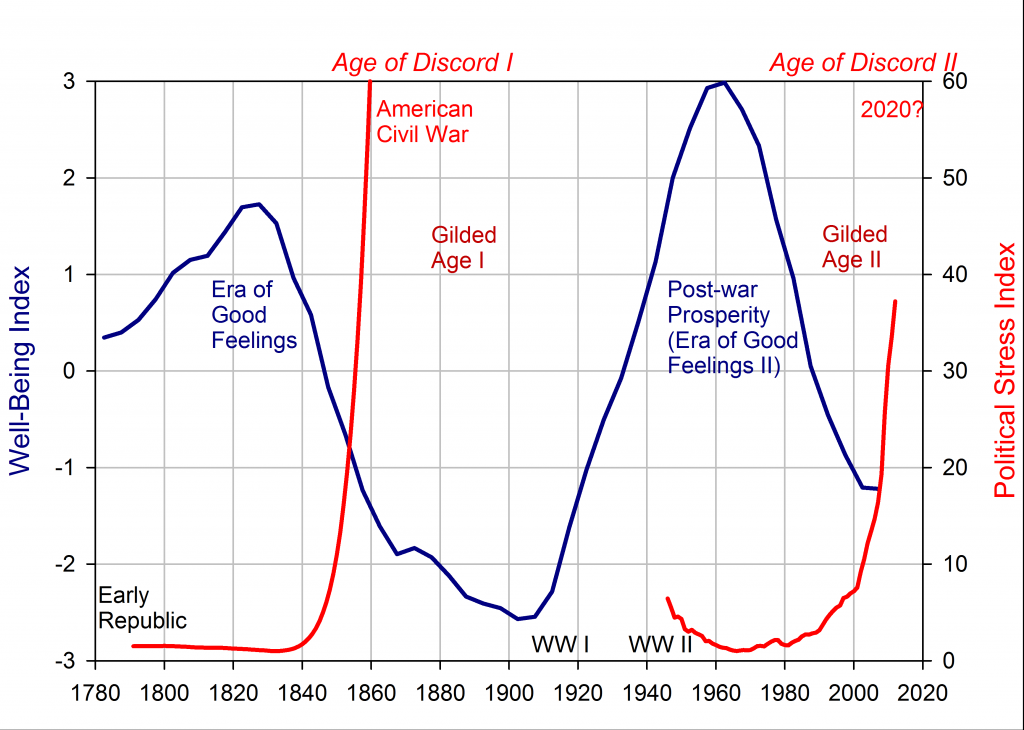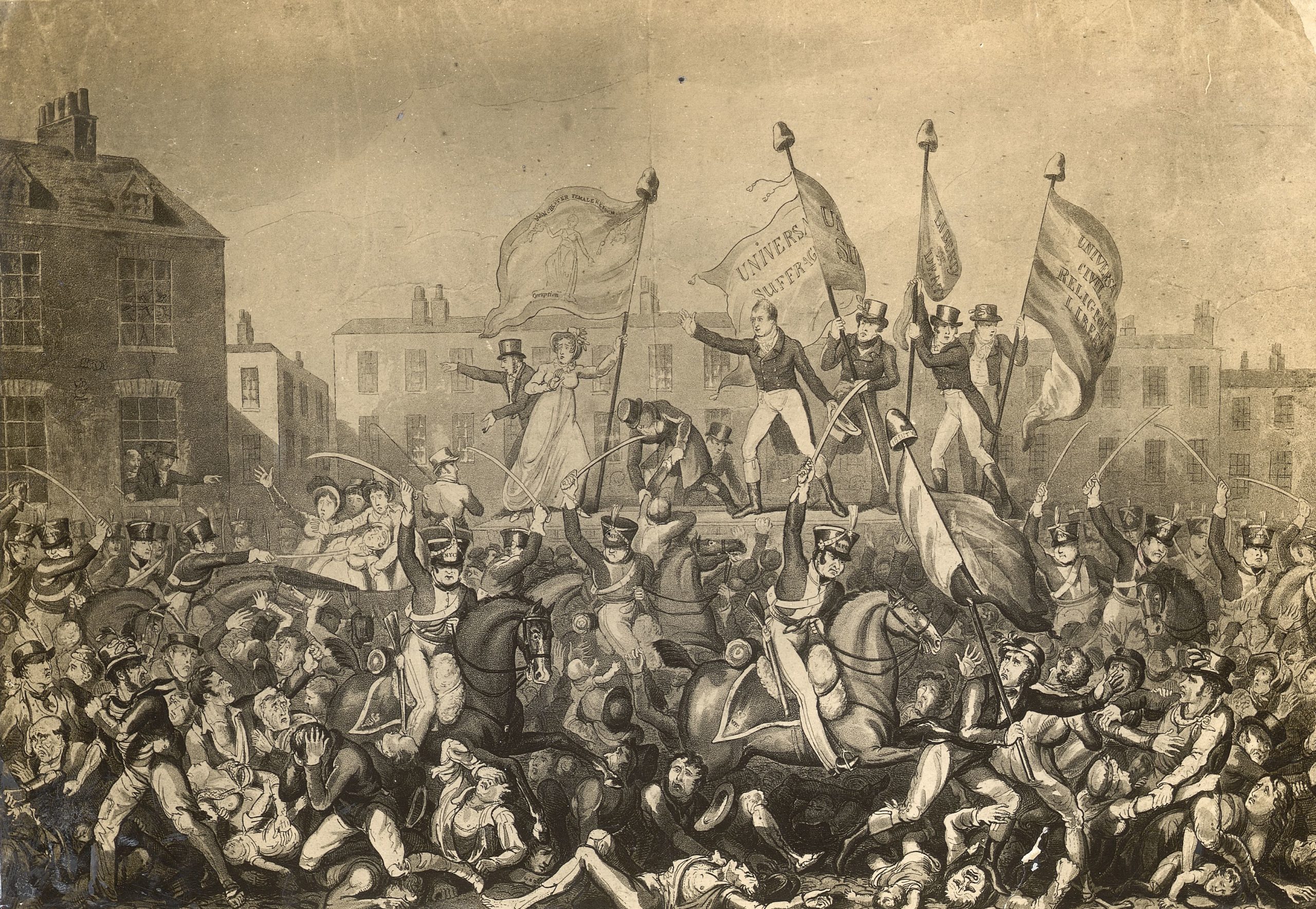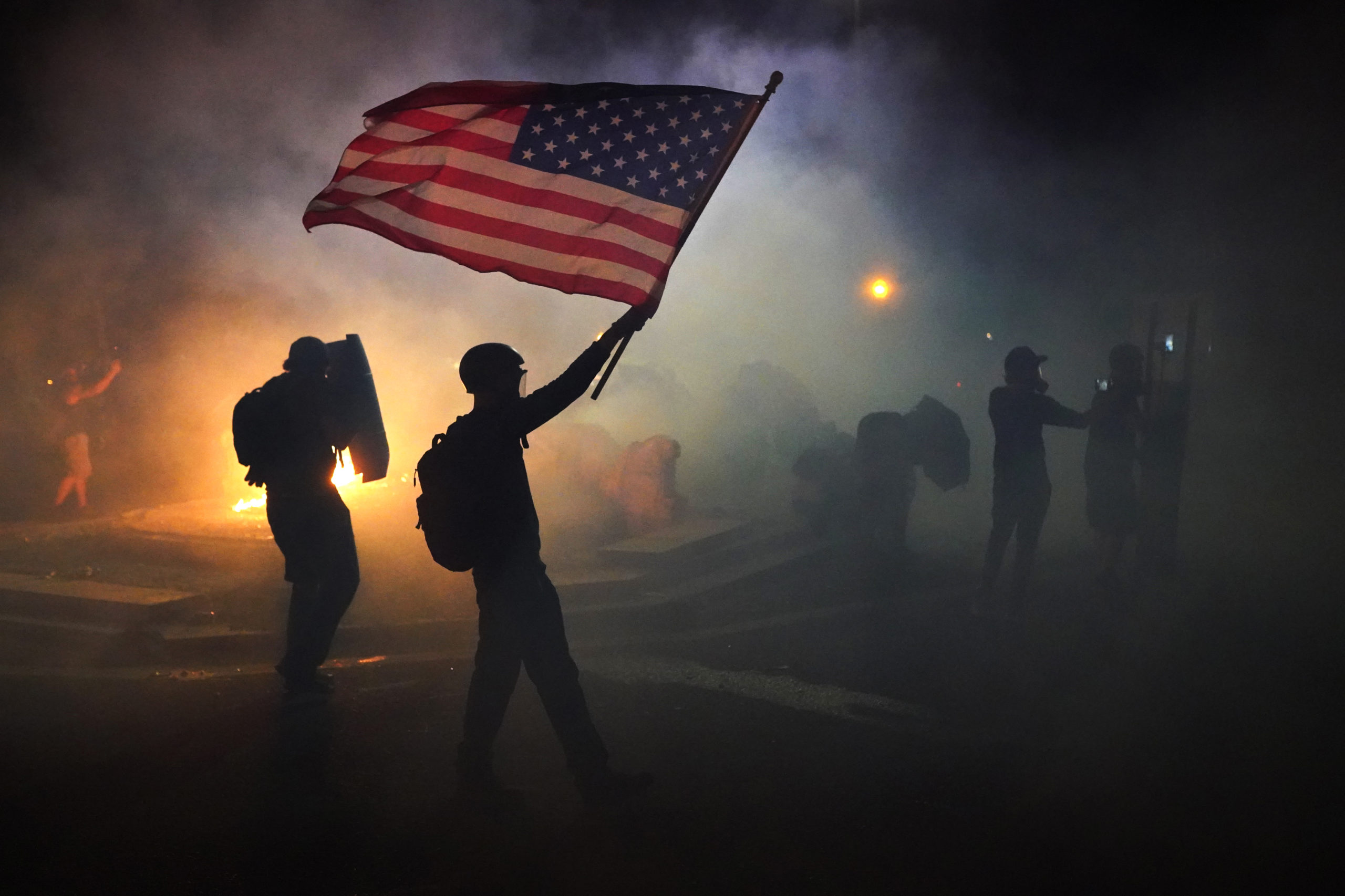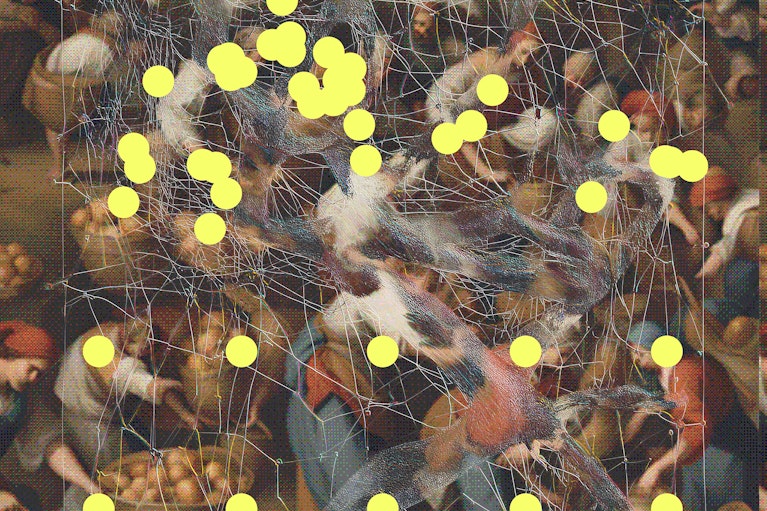Jack A. Goldstone is a sociologist, historian and professor at George Mason University. His latest book is “Revolutions: A Very Short Introduction.”
杰克·戈德斯通(Jack A. Goldstone)是乔治梅森大学的社会学家、历史学家和教授。他的最新著作是《革命:一个非常简短的介绍》。
Peter Turchin is a scientist and author specializing in cultural evolution. His latest book is “Ages of Discord: A Structural-Demographic Analysis of American History.”
彼得·图尔钦(Peter Turchin)是一位专门研究文化进化的科学家和作家。他的最新著作是《不和谐的时代:美国历史的结构人口分析》(Ages of Discord: A Structural-Population Analysis of American History)。
Almost three decades ago, one of us, Jack Goldstone, published a simple model to determine a country’s vulnerability to political crisis. The model was based on how population changes shifted state, elite and popular behavior. Goldstone argued that, according to this Demographic-Structural Theory, in the 21st century, America was likely to get a populist, America-first leader who would sow a whirlwind of conflict.
大约三十年前,我们中的杰克·戈德斯通(Jack Goldstone)发表了一个简单的模型,以确定一个国家对政治危机的脆弱性。该模型基于人口变化如何改变国家、精英和大众行为。戈德斯通认为,根据这种人口结构理论,在21世纪,美国可能会得到一个民粹主义的、美国优先的领导人,他将播下冲突的旋风。
Then ten years ago, the other of us, Peter Turchin, applied Goldstone’s model to U.S. history, using current data. What emerged was alarming: The U.S. was heading toward the highest level of vulnerability to political crisis seen in this country in over a hundred years. Even before Trump was elected, Turchin published his prediction that the U.S. was headed for the “Turbulent Twenties,” forecasting a period of growing instability in the United States and western Europe.
十年前,我们中的另一个人彼得·图尔钦(Peter Turchin)利用当前的数据将戈德斯通的模型应用于美国历史。令人震惊的是:美国正走向一百多年来这个国家对政治危机的最高脆弱性。甚至在特朗普当选之前,图尔钦就发表了他的预测,即美国将走向“动荡的二十年代”,预测美国和西欧将出现一段日益不稳定的时期。
Given the Black Lives Matter protests and cascading clashes between competing armed factions in cities across the United States, from Portland, Oregon to Kenosha, Wisconsin, we are already well on our way there. But worse likely lies ahead.
鉴于“黑人的命也是命”(Black Lives Matter)抗议活动以及从俄勒冈州波特兰市到威斯康星州基诺沙市(Kenosha, Wisconsin)的美国各地城市中相互竞争的武装派别之间的级联冲突,我们已经在实现这一目标的道路上走得很顺利。但更糟糕的情况可能还在后面。
Our model is based on the fact that across history, what creates the risk of political instability is the behavior of elites, who all too often react to long-term increases in population by committing three cardinal sins. First, faced with a surge of labor that dampens growth in wages and productivity, elites seek to take a larger portion of economic gains for themselves, driving up inequality. Second, facing greater competition for elite wealth and status, they tighten up the path to mobility to favor themselves and their progeny. For example, in an increasingly meritocratic society, elites could keep places at top universities limited and raise the entry requirements and costs in ways that favor the children of those who had already succeeded.
我们的模型基于这样一个事实,即纵观历史,造成政治不稳定风险的是精英的行为,他们经常通过犯下三宗罪来对人口的长期增长做出反应。首先,面对抑制工资和生产率增长的劳动力激增,精英们试图将大部分经济收益据为己有,从而加剧了不平等。其次,面对精英财富和地位的激烈竞争,他们收紧了流动的道路,以有利于自己和他们的后代。例如,在一个日益精英化的社会中,精英们可以限制顶尖大学的名额,并以有利于那些已经成功的人的孩子的方式提高入学要求和成本。
Third, anxious to hold on to their rising fortunes, they do all they can to resist taxation of their wealth and profits, even if that means starving the government of needed revenues, leading to decaying infrastructure, declining public services and fast-rising government debts.
第三,他们急于保住自己不断上升的财富,竭尽全力抵制对他们的财富和利润征税,即使这意味着政府缺乏所需的收入,导致基础设施衰败、公共服务下降和政府债务快速上升。
Such selfish elites lead the way to revolutions. They create simmering conditions of greater inequality and declining effectiveness of, and respect for, government. But their actions alone are not sufficient. Urbanization and greater education are needed to create concentrations of aware and organized groups in the populace who can mobilize and act for change.
这些自私的精英引领着革命的道路。它们为更大的不平等和政府效率的下降以及对政府的尊重创造了酝酿的条件。但仅凭他们的行动是不够的。需要城市化和更多的教育,以便在民众中集中有意识和有组织的群体,这些群体能够动员起来并采取行动进行变革。
“Such selfish elites lead the way to revolutions.”
“这种自私的精英引领着革命的道路。”
Top leadership matters. Leaders who aim to be inclusive and solve national problems can manage conflicts and defer a crisis. However, leaders who seek to benefit from and fan political divisions bring the final crisis closer. Typically, tensions build between elites who back a leader seeking to preserve their privileges and reforming elites who seek to rally popular support for major changes to bring a more open and inclusive social order. Each side works to paint the other as a fatal threat to society, creating such deep polarization that little of value can be accomplished, and problems grow worse until a crisis comes along that explodes the fragile social order.
高层领导很重要。以包容性和解决国家问题为目标的领导人可以管理冲突并推迟危机。然而,寻求从政治分裂中获益并煽动政治分歧的领导人使最终危机更加接近。通常,支持寻求维护其特权的领导人的精英与寻求争取民众支持重大变革以带来更加开放和包容的社会秩序的改革精英之间会出现紧张关系。每一方都努力将对方描绘成对社会的致命威胁,造成如此深刻的两极分化,以至于几乎无法实现任何价值,问题变得越来越严重,直到危机发生,破坏了脆弱的社会秩序。
These were the conditions that prevailed in the lead-up to the great upheavals in political history, from the French Revolution in the eighteenth century, to the revolutions of 1848 and the U.S. Civil War in the nineteenth century, the Russian and Chinese revolutions of the twentieth century and the many “color revolutions” that opened the twenty-first century. So, it is eye-opening that the data show very similar conditions now building up in the United States.
从18世纪的法国大革命,到1848年的革命和19世纪的美国内战,再到20世纪的俄国和中国革命,再到开启21世纪的许多“颜色革命”,这些都是政治史上大动荡的前提条件。因此,令人大开眼界的是,数据显示美国现在正在形成非常相似的情况。
In applying our model to the U.S., we tracked a number of indicators of popular well-being, inequality and political polarization, all the way from 1800 to the present. These included the ratio of median workers’ wages to GDP per capita, life expectancy, the number of new millionaires and their influence on politics, the degree of strict party-line voting in Congress, and the incidence of deadly riots, terrorism and political assassinations. We found that all of these indicators pointed to two broad cycles in U.S. history.
在将我们的模型应用于美国时,我们跟踪了从1800年到现在的一些民众福祉,不平等和政治两极分化的指标。这些因素包括工人工资中位数与人均GDP的比率、预期寿命、新百万富翁的数量及其对政治的影响、国会中严格的党派投票程度,以及致命骚乱、恐怖主义和政治暗杀的发生率。我们发现,所有这些指标都指向了美国历史上的两大周期。
In the decades following independence, despite growing party competition, elites in office often compromised and voted together, and rising national prosperity was broadly shared. But that wave of positive conditions peaked around 1820; from there, political polarization and economic inequality rose sharply in the years leading up to the Civil War. The crisis indicators peaked in the 1860s but did not fall sharply after the war; instead, they remained high until 1920 (the years of Reconstruction, Jim Crow, Gilded Age and violent labor unrest, and the anarchists).
在独立后的几十年里,尽管政党竞争日益激烈,但当权的精英们经常妥协并一起投票,国家繁荣的上升得到了广泛的分享。但这波积极条件在1820年左右达到顶峰。从那时起,政治两极分化和经济不平等在内战前的几年里急剧上升。危机指标在 1860 年代达到顶峰,但战后并未急剧下降;相反,它们一直保持在高位,直到 1920 年(重建年代、吉姆·克劳、镀金时代和暴力劳工骚乱以及无政府主义者)。
Then, the tide shifted, and a second wave of greater unity and prosperity began to gather strength. Contrary to expectations, World War I and the Great Depression did not produce a rise in political instability indicators. Instead, the country pulled together. The reforms introduced during the Progressive Era and clinched in the New Deal reduced inequality and strengthened the economic share of workers; during and after World War II, the country agreed on new tax policies and increased spending on roads and schools.
The 1950s were a golden age of worker progress and party cooperation; even in the 1960s and 1970s, despite serious racial conflicts, the country’s leaders were able to agree on remarkably far-reaching reforms to improve civil rights and environmental protection. However, the 1960s were a high point in our indicators of political resilience; in the 1970s and 1980s, things began to turn, and by the 1990s, a new wave of rising inequality and political divisions was well underway, exemplified by Newt Gingrich’s policies as speaker of the House. In the next two decades, the crisis indicators rose just as sharply as they had in the decades before the Civil War. It was not just that by the late 2010s, overall inequality was rising to the levels not seen since the Gilded Age; median wages in relation to GDP per capita also were falling to historically low levels.
Writing in the journal Nature in 2010, we pointed out that such trends were a reliable indicator of looming political instability and that they “look set to peak in the years around 2020.” In Ages of Discord, published early in 2016, we showed that America’s “political stress indicator” had turned up sharply in recent years and was on track to send us into the “Turbulent Twenties.”

This year, the COVID-19 pandemic and the death of George Floyd at the hands of the Minneapolis police have delivered a double-barreled crisis to U.S. politics. America has reacted with a nationwide, months-long series of urban protests. But this explosion of protest is not just the result of this year’s events. The U.S. has weathered epidemics and racial protests before and produced legislation that made the country better as a result. What is different this decade is that these events are occurring at a time of extreme political polarization, after decades of falling worker’s share in national income, and with entrenched elite opposition to increased spending on public services. These trends have crippled the U.S. government’s ability to mount an effective response to the pandemic, hampered our ability to deliver an inclusive economic relief policy and exacerbated the tensions over racial injustice that boiled over in response to the video of Floyd’s death.
Is the U.S. likely headed for still greater protests and violence? In a word, yes. Inequality and polarization have not been this high since the nineteenth century. Democrats are certain that if Donald Trump is re-elected, American democracy will not survive. Republicans are equally certain that if Trump loses, radical socialists will seize the wealth of elites and distribute it to underserving poor and minorities, forever destroying the economy of the United States. Both sides are also convinced that the other side intends to change the democratic “rules of the game” in ways that will make it impossible for them to compete effectively in future elections. In such conditions, elections are not merely contests over policy preferences; they become existential battles for the future of the nation. Whichever party loses is likely to view the results as rigged and the outcome as intolerable.
“Almost any election scenario this fall is likely to lead to popular protests on a scale we have not seen this century.”
The upcoming election therefore offers several outcomes that could trigger mass violence. If Trump wins narrowly in the electoral college but loses the popular vote by a large margin, there will surely be massive demonstrations protesting the outcome, calling it illegitimate and demanding allegiance to the will of the majority of Americans. Trump may then be tempted to call in federal forces to put down these protests (as in Portland), which may in turn, as in Portland, provoke even larger uprisings.
If Trump loses, he is likely to contest the outcome as a “rigged” election. But that action will again lead to massive popular protests, this time to insist that the election results be honored. If Trump again puts federal security forces in the streets, governors may ask their state troopers or even national guard to protect their citizens and defend the Constitution. Or Trump may call on his many armed civilian supporters to defend their “all time favorite president” (as he put it) against so-called “liberal tyranny.”
Many observers, based on precedents in other countries that teetered between democracy and authoritarianism, have argued that the only way forward is with a massive victory by the Democratic Party. But even that might not be sufficient. Trump might still call an overwhelming Biden victory “obviously rigged,” saying such a large victory is impossible given his base of support and claiming it was due to millions of fraudulent mail-in ballots. Or if he fears certain defeat, Trump might look for ways to postpone the election, whether due to the coronavirus pandemic or other pretext, a possibility that Trump has tweeted about and that came up in a contentious Congressional hearing on July 28. But that too would almost certainly trigger nationwide protests and possibly end up pitting anti-Trump protestors against federal forces or in violent clashes with Trump supporters.
Even if Biden appears to have achieved a large victory, much of the American public has now been instructed, and perhaps persuaded, that this result could only be due to a flawed election. This is not just a matter of Trump’s exaggerated claims; Americans no longer have an accurate sense of their own society. For example, a few years ago, a poll showed that Americans, on average, think Muslims are seventeen times as large a portion of the U.S. population as they actually are. Another poll showed that most Americans think a majority of immigrants are in the country illegally (in fact, 77% of all immigrants have fully legal status). Due to such false impressions, it is easy to claim that millions of votes were wrongly cast by people who do not have the right to vote. It would not take much prompting to bring thousands of people into the streets to contest the legitimacy of even a substantial Biden victory.
Moreover, victory on either side will likely not be clear on election night, if — as seems likely — mail-in ballots will form an unprecedented portion of the votes cast. That will allow time for both pro and anti-Trump forces to claim victory and try to mobilize supporters to demand that their victory be recognized; this is likely to end up with clashes between partisans on both sides.
In short, given the accumulated grievances, anger and distrust fanned for the last two decades, almost any election scenario this fall is likely to lead to popular protests on a scale we have not seen this century. Trump’s claims of millions of fraudulent mail-in ballots and a rigged, unfair election may be playing with fire; but our model shows there is plenty of dangerous tinder piled up, and any spark could generate an inferno.
“Our model shows there is plenty of dangerous tinder piled up, and any spark could generate an inferno.”
American exceptionalism was founded on cooperation — between the rich and the poor, between the governors and the governed. From the birth of the nation, the unity across economic classes and different regions was a marvel for European observers, such as St. John de Crèvecoeur and Alexis de Tocqueville. This cooperative spirit unraveled in the mid-nineteenth century, leading to the first “Age of Discord” in American history. It was reforged during the New Deal as an unwritten but very real social contract between government, business and workers, leading to another age of prosperity and cooperation in postwar America. But since the 1970s, that contract has unraveled, in favor of a contract between government and business that has underfunded public services but generously rewarded capital gains and corporate profits.
While this new neoliberal contract has, in some periods, produced economic growth and gains in employment, growth has generally been slower and far more unequal than it was in the first three postwar decades. In the last twenty years, real median household income has stagnated, while the loss of high-paying blue-collar jobs to technology and globalization has meant a decline in real wages for many workers, especially less educated men.
As a result, American politics has fallen into a pattern that is characteristic of many developing countries, where one portion of the elite seeks to win support from the working classes not by sharing the wealth or by expanding public services and making sacrifices to increase the common good, but by persuading the working classes that they are beset by enemies who hate them (liberal elites, minorities, illegal immigrants) and want to take away what little they have. This pattern builds polarization and distrust and is strongly associated with civil conflict, violence and democratic decline.
At the same time, many liberal elites neglected or failed to remedy such problems as opiate addiction, declining social mobility, homelessness, urban decay, the collapse of unions and declining real wages, instead promising that globalization, environmental regulations and advocacy for neglected minorities would bring sufficient benefits. They thus contributed to growing distrust of government and “experts,” who were increasingly seen as corrupt or useless, thus perpetuating a cycle of deepening government dysfunction.
How can Americans end our current Age of Discord? What we need is a new social contract that will enable us to get past extreme polarization to find consensus, tip the shares of economic growth back toward workers and improve government funding for public health, education and infrastructure.
This sounds like commonplace leftist discourse and a weak response to such extreme conditions. Let us therefore drive home both the urgency of the crisis and the possibility of changing course by looking at two historical cases where countries teetered on the brink of calamity but managed to pull back and forge a new path to progress.
The United Kingdom in the 1820s was coming apart. After defeating Napoleon, the Duke of Wellington became the leader of an elite group that sought to maintain the dominance of the traditional landlord elites. As prime minister and then leader of the House of Lords, Wellington sought to ignore, rather than adjust to, the new realities of the booming cities of Birmingham, Manchester and other burgeoning cities of the fast-growing industrial economy. Meanwhile, the workers of these cities demanded political reforms that would give them a voice in Parliament.
These workers particularly objected to the infamous “Corn Laws,” which, by placing tariffs on imports of foreign grain, kept the costs of food (and hence the profits of English landlords) high and the real wages of workers low. Following a major workers’ protest in Manchester in 1819, which was dispersed with a cavalry charge into the crowd that left an estimated 10 to 20 dead and hundreds injured (the so-called Peterloo massacre), politics in Britain became even more sharply polarized. This became one of the first incidents widely reported by journalists, and indignation spread across the country.

Nonetheless, Wellington not only refused any legal changes, he sought to clamp down on the agitation for voting reforms. New laws were passed to expand police power and block public assemblies; newspapers were closed; protestors and journalists were jailed. Still, popular agitation continued, and there was even an attempt to assassinate several cabinet ministers. The rapid growth of the industrial workforce and the new manufacturing economy produced similar pressures for radical political change across Europe, leading to waves of revolutions in 1830 and 1848. Many in Britain expected a similar outcome, yet the country avoided revolution throughout these years.
The solution was for leaders to accept the Reform campaign, which sought voting reforms that would reduce the power of the landlords and support the new industrial working class. After the growing confrontations of the 1820s, in 1830, Wellington’s Tories lost control of Parliament, and a Whig leader who supported the Reform campaign, Lord Grey, became prime minister. Grey’s initial efforts to pass a Reform bill were frustrated, and Grey threatened to have the King create enough additional Whig peers to force the bill through. The Tories then relented, and in 1832, Parliament passed the first Reform bill, which expanded the franchise, undermined the clientage of the landed elite and gave representation to the residents of the factory cities. Additional Reform bills followed, allowing Britain, despite continued large-scale workers’ movements, to avoid the revolutions that wracked the continent and emerge as the leading economy of Europe.
“Adapting to new social and technological realities required having the wealthy endure some sacrifices.”
A century later, it was the United States that was coming apart. In the early 1930s, democracy was retreating in Europe while the U.S. economy had fallen into a depression, with a dust bowl in the Great Plains and millions of industrial workers losing their jobs. Prohibition had heightened cultural conflict and crime, while nativist demagogues (such as radio personality Father Coughlin and Louisiana Governor Huey Long) stirred fear.
Then in 1932, Americans voted for change. Franklin Delano Roosevelt replaced Herbert Hoover as president and undertook a sweeping reform program to restore work and shared prosperity. Labor organizations were strengthened, and public works programs provided jobs for construction workers, craftsmen and artists. The resulting buildings were decorated with monuments to the dignity of labor. It took years to transition to an economy based on mechanization, skilled labor, strong unions and public education, but the result was a country strong enough to fight the rising tide of global fascism and emerge as the world’s leading economy.
The formula in both cases was clear and simple. First, the leader who was trying to preserve the past social order despite economic change and growing violence was replaced by a new leader who was willing to undertake much-needed reforms. Second, while the new leader leveraged his support to force opponents to give in to the necessary changes, there was no radical revolution; violence was eschewed and reforms were carried out within the existing institutional framework.
Third, the reforms were pragmatic. Various solutions were tried, and the new leaders sought to build broad support for reforms, recognizing that national strength depended on forging majority support for change, rather than forcing through measures that would provide narrow factional or ideologically-driven victories. The bottom line in both cases was that adapting to new social and technological realities required having the wealthy endure some sacrifices while the opportunities and fortunes of ordinary working people were supported and strengthened; the result was to raise each nation to unprecedented wealth and power.
To be sure, the path back to a strong, united and inclusive America will not be easy or short. But a clear pathway does exist, involving a shift of leadership, a focus on compromise and responding to the world as it is, rather than trying desperately to hang on to or restore a bygone era.
This has already been, and will continue to be, a violent year in America. We need to brace for post-election violence and prepare bipartisan methods to ensure that the election outcome will be widely regarded as fair and legitimate. It will take heroic efforts to rebuild the political center, to join businesses and workers in partnership and consensus, and to restore fairness in both taxation and public spending. Only if all sides can again recover a stake in our government, no matter which party controls it, can we avoid sliding into a crisis that will undermine our Constitution and pit Americans against each other in a way we have not seen for generations.





